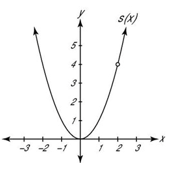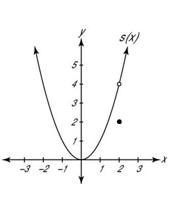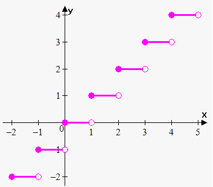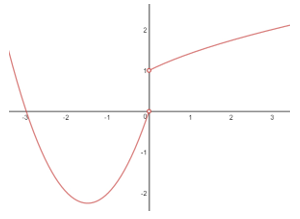Contents:
- What is a Rational Function?
- What is a Proper Rational Function?
- Limit of a Rational Function
- Integration of Rational Fractions
- Holes in Rational Functions
- Simplify a Rational Function on the TI-89
What is a Rational Function?
A rational function is any function where one polynomial function is divided by another. All polynomials are rational functions, because every polynomial can be written as a quotient of itself divided by 1.
It’s “rational” because the two polynomials form a ratio (i.e., a fraction). All of the following functions are rational functions:
- f(x) = x / (x – 3)
- f(x) = x2 + 5 / (x + 2)
- f(x) = = (a0 + a1x + a2x2 + … + anxn) / b0 + b1x + b2x2 + … + bmxm
You must have a valid polynomial in both the numerator and denominator. You can’t have:
- Square roots of the independent variable: √(x)
- Square roots of the entire expression:

- Fractional exponents: x½
Rational functions are defined everywhere except where zeros appear in the denominator.
Domain and Range of a Rational Function
Division by zero in a function is never allowed, so the domain for all rational functions is any real number except for anything that results in the denominator equaling zero. For example, f(x) = 5/x has a domain of all real numbers except for zero, because 3/0 is undefined. The range can be found by finding the domain of the inverse function, or by looking at a graph. Watch the video for a couple of quick examples:
What is a Proper Rational Function?
A proper rational function is a ratio of functions where the degree of the numerator (the top number in a fraction) is less than the degree of the denominator (the bottom number).
The function has the form:

Where:
- P(x) and Q(x) are polynomials, and
- The degree of P(x) is less than the degree of Q(x).
It’s very similar to the idea of an proper fraction in algebra, where the numerator is smaller than the denominator. Like it’s cousin the improper fraction (where the numerator is larger than the denominator), a rational function is improper if the degree of the numerator is bigger than the degree of the denominator.
Rewriting Improper Rational Functions
Remember in algebra that you can rewrite an improper fraction as the sum of a whole number and a fraction? Improper rational functions can also be rewritten, as the sum of a proper rational function and a polynomial.
More formally, that’s:
if R(x) = P(x) / Q(x) is a rational function and the degree of Q(x) is greater than zero, then there are polynomials M(x) and N(x) such that:

The degree of N(x) is less than the degree of Q(x).
Examples of Proper Rational Functions
One example of a proper rational function is

Notice that the degree of the numerator(4) is less than the degree of the denominator (5).
The rational function:

has a higher degree in the denominator then in the numerator, so it isn’t proper.
Limit of a Rational Function
The limit of a rational function r(x) = p(x)/q(x) is the function value at point c as long as c is a real number and q(c) ≠ 0.
For example, the limit of f(x) = (x2 + x + 2) / (x + 1) at x = 1 is:
f(x) = (12 + 1 + 2) / (1 + 1) = 4 / 2 = 2
Integration of Rational Fractions
One reason it is important to be able to identify a proper rational fraction is that these are the only rational fractions that can be integrated using the method of partial fractions. If you come across an improper rational fraction, you will first need to rewrite it as a proper rational fraction and a polynomial. Usually you would do this using long division. Then you can integrate.
On the TI-89 graphing calculator the propFrac( command rewrites in improper rational function as a polynomial plus a proper rational fraction.
Step 1: Press the HOME key
.
Step 2: Press F2 and then 7 to select the “propFrac(” command.
Step 3: Enter your function. For example:
( x ^ 2 – 3 x + 5 ) ÷ ( x + 4 ) ).
Step 4: Press the ENTER key.
The result for the above example would give you the sum of a proper fraction (33 / x + 4) and a linear polynomial function (x – 7).
Holes in Rational Functions
A hole in a rational function is a removable discontinuity that breaks continuity for that function. Finding a hole within a rational function helps identify specific x-values that are to be excluded in intervals when using certain theorems (i.e. Mean Value Theorem, Integrals, Rolle’s Theorem, etc.). Theorems requiring continuity would create issues in getting any meaningful conclusion for functions with holes present.
A rational function takes the form of f(x) = g(x) / h(x), where g(x) and h(x) are polynomial functions. Holes in rational functions are depicted as an open circle for a solvable set of x coordinates. The discontinuity leaves the function with the identified x coordinate(s) of their lacking y value and can be seen graphically.
Graphical Representation
For the visualization of holes in rational functions, take the function s(x) depicted below:

The x value of x = 2 has an open hole drawn that visually looks like it could have a y value of y = 4. The hole in s(x) has no actual y value (i.e. function output). However, limits can give you an idea of what the corresponding y value should look like, using the limit from the left side and limit from the right side of x = 2;
However, the missing y value at x = 2 can exist if an initial value is defined. For the same s(x), we can be told that at s(2) = 2. In other words, you’re being told that for an initial x-value of 2, the y-value (the function output) is also 2; the y value exists even though there is a hole in the graph. The graph below depicts such an occurrence where the point (2,2) came from the initial value:

Types of Hole Discontinuity
Holes exist for functions that can include other types of discontinuities. One type is a Jump Discontinuity that comes in two forms: One-Sided Discontinuity and Two-Sided Discontinuity. The title is given by the “jump” the function takes on a specific x value from one y-value to another. The image below depicts one-sided discontinuity:

Where the x-values that have holes (depicted by open circles) contain an evaluated “jumped” y-value (depicted as solid circles) right above them. Generally, one-sided discontinuity’s holes can be located above and below the “jumped” y-value and depend solely on how the given function is defined as equation-wise and initial-value-wise.
Two-Sided Discontinuity is where a jump is present but two holes exist at one x-value. This discontinuity makes the value being approached from the left and right side, for the holed x coordinate, be equal to two different y-values. Thus, that x-value cannot be evaluated and will cause problems when taking the derivative or integral of this function. Visually depicted below, no definite y-value exists for unless an initial value is given (which would be depicted as a solid circle somewhere above, below, or in between the two holes.

General Solving Process
Rational Functions that take the form of f(x) = g(x) / h(x) have the potential to contain a hole because of common factoring that takes place. A zero that is factored from g(x) and/or h(x) that is common between the numerator and denominator is what removes the dependent y value from that factored zero (Bogley, 1996).
The zero is factored out first in the denominator. If the same zero can be factored out in the numerator, a hole is located at that zero value on the x-axis. If no similar factoring can occur in the rational function, the zero in the denominator acts as a vertical asymptote instead.
Overall, the rational function f(x) = g(x) / h(x) has a hole at x = a if
- Both g(x) and h(x) have a common factor of ( x – a ), and
- A simplified form of f(x) has a denominator that does not have the factor ( x – a ).
Finding Holes in Rational Functions Example
Let us attempt to find the hole location(s) on the x-axis algebraically:

Step 1: We factor the denominator into two separable quantities by performing reverse FOIL.
For x2 – x – 2, we require two quantities where 1 and -2 are present with the variable “x”.
We can try (x + 1)(x – 2) = x2 – 2x + x – 2 = x2 – x – 2, thus we have our simplified denominator:

Where the quantity (x + 1) is common for both numerator and denominator.
Step 2: Identify the zero for the common factor within the rational function. That zero is the x-value for the function’s hole.
Since (x + 1) is the identified common factor, (x + 1) = 0 shows that the zero is x = -1.

Simplify (TI 89)

Knowing how to simplify expressions in calculus is essential to being able to differentiate functions. The TI-89 graphing calculator makes simplifying expressions an easy task. In fact, you don’t even have to access a menu; The TI-89 can perform expression simplification right on the home screen. There is another way—using the propFrac command.
Simplify TI 89 Example 1: Using the HOME screen
If you have a very simple expression, type it into the HOME screen and the calculator will do the rest.
Sample problem: simplify the following expression with the TI-89:
f(x) = 9x + 8x
Step 1: Press the [HOME] key.
Step 2: Press [9] [X] [+] [8] [X] to enter the expression.
Step 3: Press [Enter]. Your answer should be 17x.
Simplify TI 89 Example 2: Using propFrac
For more complicated equations, like ((x2 + 3x + 2)/(x + 1)), entering it as-is on the HOME screen won’t work. All you’ll see is your entry repeated. This is when you’ll want to use propFrac.
Step 1: Press F2, then 7 to select propFrac from the HOME screen.
Step 2: Type your expression in. Make sure you type in a closing parentheses “)”.
Step 3: Press the ENTER key. For ((x2 + 3x + 2)/(x + 1)), the simplified expression is x + 2.
Caution: Although the calculator returns the correct answer, it might not be formatted in the way you’re accustomed to.
TI 89 PropFrac Command Example 3: Using PropFrac to convert Rational to Proper Fractions
A rational fraction (also called a rational expression) is a fraction that has a numerator and denominator with rational numbers. A proper fraction has a top number that is smaller than it’s bottom number. For example, 5/3 and 8/4 are proper fractions. Converting fractions is tedious by hand, not to mention that (if you’re like me) you’ll make small mistakes. Add a variable or two (like x or y) to the mix and the process can be quite time consuming. However, the TI 89 propFrac command makes it a snap to convert to proper fractions.
Example question: Convert the following rational function to a proper fraction.
f(x) = (x>sup>2 + x + 3) / (x – 2)
Step 1: Press the Home key.
Step 2: Press the F2 button and then press the 7. This key combination selects the TI 89 propFrac( command.
Step 3: Press the following keys: ( ( x ^ 2 + x + 3 ) / ( x – 2 ) )
Note: Make sure you type in all of the parentheses. Missing parentheses are the usual culprit for mathematical errors or for the calculating give you an “error domain” or some other ugly error message.
Step 4: Press [ENTER].
The calculator will display the solution, which is (9) / (x – 2) + (x) + 3.
That’s it! You’re done! You can now convert any rational function to a proper fraction using the TI-89!
Check out our YouTube channel for hundreds videos, including help with the TI-calculators and Microsoft Excel.
References
Bogley, William A., and Robby Robson. Review of Rational Functions. Calculus Quest, 1996, oregonstate.edu/instruct/mth251/cq/FieldGuide/rational/more.html.
Knopp, K. (1996). “Rational Functions.” §35 in Theory of Functions Parts I and II, Two Volumes Bound as One, Part I. New York: Dover, pp. 96 and 137-139.
Proper Rational Function. HMC Calculus Tutorials. Retrieved from https://www.math.hmc.edu/calculus/tutorials/partial_fractions/proper.pdf on March 31, 2019.
Rathjen, Michael. Rational Fractions and Partial Fractions. Retrieved from https://www1.maths.leeds.ac.uk/Pure/staff/rathjen/CIVE1619ch2.pdf on March 31, 2019.
Chow, Bennet. Proper Rational Functions. USCD Math Department. Retrieved from http://www.math.ucsd.edu/~benchow/SS216/PF.pdf on March 31, 2019.